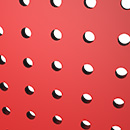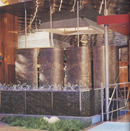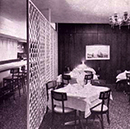
Perforate
Perforate is a regular pattern of consistently shaped and spaced holes that have been cut into a material. more
Perforate | Restaurant
application
In restaurants Perforate is primarily used for partitions between different dining areas to create visual privacy and as a decorative element to support the design concept of the space.
research
Although Perforate is evident in traditional Islamic art, western countries did not appropriate it until the 20th century. However, for a brief period in the 1960s Moroccan-inspired décor became fashionable in restaurants, primarily in the form of perforated screens.1 An early example is the Detroit restaurant, McGuire’s. Its modular wrought iron grille, designed by Julius Blum, separates the lounge from the main dining area. Restaurant interiors of this time period are strikingly plain in surface finishes and furnishings, and decorative screens gave these spaces some character.
During the 1970 and 1980 decades Perforate fades from use, but it emerges again in the 1990s as an archetypical practice in retail, education, healthcare and restaurants in the form of metal and wooden screening.
In 1990 the Shunju in Tokyo employed Perforate to express the restaurant’s cultural design concept, shinju. The word is comprised of two characters that signify spring and autumn, seasons that in Japan are marked by pleasant temperatures, diaphanous light, perfumed air. The restaurant’s designer also drew from the traditional Japanese Sukiya style of teahouse construction (light, delicate, fragile) to divide two dining areas by a wooden screen in a hexagonal pattern.2 Nine years later, in 1999, Jeffrey Beers used perforated elements in the China Grill in Las Vegas. In Beers’ hands, Perforate becomes an entrance device of four panels that are industrial and whimsical—square perforations in sheet metal. The same metal sheeting in the form of large, recessed illuminating cones punctuate the ceiling plane. The reflection of the elements below creates undulating patterns on the ceiling.3
The 21st century restaurants LOTUS in New York City and the Koi in Los Angeles illustrate the differences between Perforate executed as a fine mesh screen and as an exaggerated screen. In the LOTUS a curved full-height screen visually separates a round booth in the dining area from the hallway. The size of the perforations is small enough to give the dining side autonomy. Conversely, the perforations in Lionel Ohayon’s over-scaled screen accentuate its openings. In fact, it is difficult to read it as a screen, because it is more decorative partition than a visual hindrance. The out-sized screen itself becomes more prominent than the furniture and the diners.
Some restaurant screens are dramatically lit by the installation of LEDs behind the perforations, a technique that displays texture. With the use of different colors of lighting, screens become dynamic pixilated digital walls.
The chronological image sequence demonstrates how Perforate can be static, inert, like a plain wall that offers some texture, but recedes into the background. In most instances though, Perforate adds energy or vigor to interiors by manipulating the shape of the screen, the size and shape of the openings, materials and accent lighting.4
end notes
- 1) Elizabeth O’Brien identified and named “Perforated” as a material in Elizabeth O’Brien, “Material Archetypes: Contemporary Interior Design and Theory Study” (M.A. Thesis, Cornell University, 2006), 11-19.
- 2) Saitoh Hideo and Joao Rodolfo Stroeter, Interior Design in Cafes and Restaurants (Tokyo: Bijutsu Shuppansha, 1992), 64-73.
- 3) Matteo Vercelloni, New Restaurants in USA 2 (Milano: L’archivolto, 2003), 12-25.
- 4) Evidence for the use and the chronological sequence of Perforate as a restaurant archetype was developed from the following sources: 1960 McGuire's Restaurant [1961] Kenneth A. Hopkins, Lawrence H. Wilson Associates; Detroit, MI in "Restaurants," Interior Design 32, no. 4 (Apr. 1961): 148; PhotoCrd: Anonymous / 1990 Shunju Restaurant [1990] Super Potato; Tokyo, Japan in Saitoh Hideo and Joao Rodolfo Stroeter, Interior Design in Cafes and Restaurants (Tokyo: Bijutsu Shuppansha, 1992), 68-70; PhotoCrd: Todoroki Chikao; Bistro Garden [1992] Janet Polizzi; Los Angeles, CA in Andrea Loukin, "Bistro Garden," Interior Design 63, no. 2 (Feb. 1992): 135; PhotoCrd: Charles White; China Grill [1999] Jeffrey Beers; Las Vegas, NV in Matteo Vercelloni, New Restaurants in USA 2 (Milano: L'archivolto, 2003), 14; PhotoCrd: Paul Warchol / 2000 MOD [2000] Suhail Design Studio; Chicago, IL in Lisa Skolnik, "MOD Is in the Details," Interiors 159, no. 8 (Aug. 2000), 67; PhotoCrd: Douglas Fogelson; Mikazuki Restaurant and Bar [2001] Suppose Design Office; Noino, Japan in Joachim Fischer, ed., Restaurant Design (Stuttgart, Germany: Daab Press, 2004), 342; PhotoCrd: Nacasa and Partners, Inc.; Daidaiya Ginza Restaurant and Bar [2001] Hashimoto Yukio Design Studio; Tokyo, Japan in Joachim Fischer, ed., Restaurant Design, 150; PhotoCrd: Martin Nicholas Kunz; LOTUS Restaurant [2001] Nancy Mah & Scott Kester; New York City in Pilar Guzman, "Eat, Drink, Man, Woman," Interiors 160, no. 3 (Mar. 2001): 88; PhotoCrd: Anne Katrine Senstad; Lever House Restaurant and Bar [2003] Mark Newson; New York City in Fischer, Restaurant Design, 302; PhotoCrd: Anonymous; The Loft Restaurant and Bar [2003] Dale Jones-Evans PTY LTD Architects; Sydney, Australia in Fischer, Restaurant Design, 96; PhotoCrd: Paul Gosney; Juan Valdez Café [2005] Hariri & Hariri Architecture; New York City in Michael Webb, "Perking Up," Hospitality Design 27, no. 3 (Apr. 2005), 175; PhotoCrd: Doug Warchol; Koi Restaurant [2005] Lionel Ohayon; Los Angeles; Stacy Shoemaker, "Found in Translation," Hospitality Design 27, no. 4 (May/June 2005): 60; PhotoCrd: Frank Oudeman; Frisson [2005] Scott Kester and Architecture TM; San Francisco, CA in Zahid Sardar, "Bon Vovage," Interior Design 76, no. 2 (Feb. 2005), 172; PhotoCrd: David Wakely; Ahmanson Founders Room [2007] Belzberg Architects; Los Angeles, CA in Michael Webb, "Musical Chairs," Hospitality Design 27, no. 4 (Nov. 2007): 112; PhotoCrd: Benny Chan; Stripsteak [2007] Super Potato; Las Vegas, NV in Kurt Handbauer, "Meat and Potato," Interior Design 78, no. 2 (Feb. 2007), 150; PhotoCrd: Eric Laignel; Blue Velvet [2007] Mandi and Mehdi Rafaty; Los Angeles, CA in Edie Cohen, "Into the Blue," Interior Design 78, no. 9 (July 2007): 58; PhotoCrd: Eric Axene; Eiffel Tower-LeJules Verne [2008] Patrick Jouin; Paris, France in Ian Phillips, "Tower of Power," Interior Design 79, no. 3 (Mar. 2008), 231; PhotoCrd: Eric Laignel.
bibliographic citations
1) The Interior Archetypes Research and Teaching Project, Cornell University, www.intypes.cornell.edu (accessed month & date, year).
2) Cho, Jasmin. “Theory Studies: Archetypical Practices of Contemporary Restaurant Design.” MA Thesis, Cornell University, 2009, 95-101.



